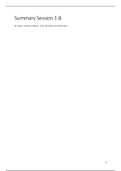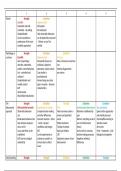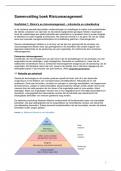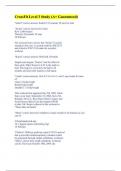Articles, Lecture Notes, Case Studies and Glossary
1
,Table of Contents
SUMMARY SESSION 1-8.................................................................................................................................. 1
Table of Contents .......................................................................................................................................... 2
SESSION 1 – CHANGING COMPETITIVE LANDSCAPE AND INCUMBENTS .......................................................... 4
1. VIDEO: NATALIE PAINCHAUD ON OVERCOMING ORGANIZATIONAL INERTIA............................................................... 4
2. ARTICLES ..................................................................................................................................................... 5
2.1. Article 1: Sull DN. 1999. Why good companies go bad. Harvard Business Review 77(4): 42. ......... 5
2.2. Article 2: Gilbert CG. 2005. Unbundling the Structure of Inertia: Resource Versus Routine Rigidity.
Academy of Management Journal 48(5): 741-763. ....................................................................................... 7
2.3. Article 3: Kapoor R, Klueter T. 2015. Decoding the Adaptability–Rigidity Puzzle: Evidence from
Pharmaceutical Incumbents’ Pursuit of Gene Therapy and Monoclonal Antibodies. Academy of
Management Journal 58(4): 1180-1207...................................................................................................... 10
3. CASE STUDY – POLAROID .............................................................................................................................. 12
4. LECTURE NOTES .......................................................................................................................................... 14
SESSION 2 – BUSINESS MODEL INNOVATION ................................................................................................ 17
1. VIDEO: BUSINESS MODEL INNOVATION – AMAZON, SPOTIFY, TINDER ................................................................... 17
2. ARTICLES ................................................................................................................................................... 18
2.1. Article 1: Johnson MW, Christensen CM, Kagermann H. 2008. Reinventing your business model.
Harvard. Business Review 86(12). ............................................................................................................... 18
2.2. Article 2: Amit R, Zott C. 2012. Creating Value Through Business Model Innovation. MIT Sloan
Management Review 53(3). ........................................................................................................................ 21
2.3. Article 3: Markides, C. and Charitou, C.D., 2004. Competing with dual business models: A
contingency approach. The Academy of Management Executive, 18(3). ................................................... 24
3. CASE STUDY – NETFLIX ................................................................................................................................. 29
4. LECTURE NOTES .......................................................................................................................................... 31
SESSION 3 – DEVELOPING STRATEGIC FORESIGHT ........................................................................................ 35
1. VIDEOS ...................................................................................................................................................... 35
1.1. Video 1: Explore Influencing Factors ............................................................................................. 35
1.2. Video 2: Develop a Map of Potential Futures................................................................................ 36
1.3. Video 3: Develop a Map of Potential Future Issues ....................................................................... 37
2. ARTICLES ................................................................................................................................................... 38
2.1. Article 1: Huntley, W. L., Bock, J. G., & Weingartner, M. (2010). Planning the unplannable:
Scenarios on the future of space. Space Policy, 26(1), 25-38. ..................................................................... 38
2.2. Article 2: Wulf, T., Meissner, P., & Stubner, S. (2010). A scenario-based approach to strategic
planning: Integrating planning and process perspective of strategy. Leipzig Graduate School of
Management. .............................................................................................................................................. 42
3. CASE STUDY – CAPITALISM’S NEXT FRONTIER ................................................................................................... 47
Capitalism’s Next Frontier: Competing in Outer Space, A. Ivey Publishing Case Study. W16564. 2016. ..... 47
4. LECTURE NOTES .......................................................................................................................................... 49
SESSION 4 – STRATEGIC ALLIANCES .............................................................................................................. 50
1. VIDEO ....................................................................................................................................................... 50
2. ARTICLES ................................................................................................................................................... 51
2.1. Article 1: Lavie D. 2006. The competitive advantage of interconnected firms: An extension of the
resource-based view. Academy of Management Review 31(3): 638-658. .................................................. 51
2.2. Article 2: Dyer JH, Singh H. 1998. The relational view: Cooperative strategy and sources of
interorganizational competitive advantage. Academy of Management Review 23(4): 660-679. .............. 57
2.3. Article 3: Hoang H, Rothaermel FT. 2016. How to Manage Alliances Strategically. MIT Sloan
Management Review 58(1): 69-76. ............................................................................................................. 61
3. CASE STUDY – GENERAL MOTORS AND NUMMI .............................................................................................. 63
3. LECTURE NOTES .......................................................................................................................................... 68
SESSION 5 – OPEN INNOVATION................................................................................................................... 72
2
, 1. VIDEO – OPEN INNOVATION: PROUDLY FOUND ELSEWHERE ................................................................................ 72
2. ARTICLES ................................................................................................................................................... 73
2.1. Article 1: Huston L, Sakkab N. 2006. Connect and develop: Inside Procter & Gamble's new model
for innovation. Harvard Business Review 84(3). .......................................................................................... 73
2.2. Article 2: Berchicci L. 2013. Towards an open R&D system: Internal R&D investment, external
knowledge acquisition and innovative performance. Research Policy 42(1). .............................................. 75
2.3. Article 3: Laursen K, Salter AJ. 2014. The paradox of openness: Appropriability, external search
and collaboration. Research Policy 43(5). ................................................................................................... 78
3. CASE STUDY – MERCK (IN 2009): OPEN FOR INNOVATION? ................................................................................ 81
4. LECTURE NOTES .......................................................................................................................................... 86
SESSION 6 – FORMULATING STRATEGIC OPTIONS FOR FORESIGHTED ISSUES ............................................... 89
1. VIDEOS ...................................................................................................................................................... 89
1.1. Video 1: Developing Strategic Postures to the Future ................................................................... 89
1.2. Video 2: Developing Strategic Postures to the Future Arena ........................................................ 90
1.3. Video 3: Formulate a Strategy for Foresighted Issues ................................................................... 91
2. ARTICLES ................................................................................................................................................... 92
2.1. Article 1: Courtney, H., Kirkland, J., & Viguerie, P. (1997). Strategy under uncertainty. Harvard
business review, 75(6), 67-79. ..................................................................................................................... 92
3. CASE STUDY - APPLE .................................................................................................................................... 96
4. LECTURE NOTES .......................................................................................................................................... 99
SESSION 7 – INNOVATION ECOSYSTEMS ......................................................................................................100
1. ARTICLES ................................................................................................................................................. 100
1.1. Article 1: Adner R. 2006. Match your innovation strategy to your innovation ecosystem. Harvard
Business Review 84(4): 98. ........................................................................................................................ 100
1.2. Article 2: Adner R, Kapoor R. 2010. Value creation in innovation ecosystems: how the structure of
technological interdependence affects firm performance in new technology generations. Strategic
Management Journal 31(3): 306-333. ....................................................................................................... 103
1.3. Article 3: Kapoor R, Lee JM. 2013. Coordinating and competing in ecosystems: How
organizational forms shape new technology investments. Strategic Management Journal 34(3): 274-296.
108
3. CASE STUDY – HONEYWELL ......................................................................................................................... 112
The Heat Is On: Emerging Ecosystems in the Thermostat Industry ........................................................... 112
4. LECTURE NOTES ........................................................................................................................................ 115
SESSION 8 – LEADERSHIP AND STRATEGIC CHANGE .....................................................................................120
1. VIDEO: 3 KEY LEADERSHIP MISTAKES DURING ORGANIZATIONAL CHANGE - CORPORATE TRAINER DANA BROWNLEE ... 120
2. ARTICLES ................................................................................................................................................. 121
2.1. Article 1: What the Best Transformational Leaders Do? Harvard Business Review. ................... 121
2.2. Article 2: Shamir, B., House, R. J., Arthur, M. B. 1993. The motivational effects of charismatic
leadership - A self-concept-based theory. Organization Science 4(4): 577-594. ....................................... 123
2.3. Article 3: Denis JL, Lamothe L, Langley A. 2001. The dynamics of collective leadership and
strategic change in pluralistic organizations. Academy of Management Journal 44(4): 809-837. ........... 128
3. CASE STUDY – THE RISE AND FALL OF BLACKBERRY .......................................................................................... 133
4. LECTURE NOTES ........................................................................................................................................ 136
GLOSSARY ...................................................................................................................................................139
3
, Session 1 – Changing Competitive Landscape and
Incumbents
Session Objectives:
- How new technologies and/ business models change the competitive landscape in
an industry;
- Why incumbents (established companies in an industry) are badly hit by these
changes;
- How incumbents can embrace new developments and stay competitive.
1. Video: Natalie Painchaud on Overcoming Organizational Inertia
Breaking the business as usual habit: organizational inertia, an addiction to the ‘businesses’
usual’. Everyday behavior that holds us back: ‘just the way things are done here’.
For a culture of innovation, new behaviors are needed that must be exercised by everyone.
CEOs must be the leaders/examples of innovation. For example, DBS wanted better meetings.
MOJO: meeting owner, joyful observer. For every meeting there are rules of engagement, the
meeting owner ensures that there is an agenda and that decisions are being made, while the
joyful observer gives feedback. Every voice must be heard.
‘You take the risk; I take the blame’: take away feel of failure by taking the blame if some
innovational action goes wrong.
4
, 2. Articles
2.1. Article 1: Sull DN. 1999. Why good companies go bad. Harvard Business Review
77(4): 42.
Active Inertia: organization’s tendency to follow established patterns of behavior—even in
response to dramatic environmental shifts.
Victims of Active Inertia
- Firestone Tire & Rubber: couldn’t keep up with the radial tires of Michelin, even though
they invested nearly $400 million dollars in radial production during the 1960’s. In
1988, they were taken over by Bridgestone. So why did they fall?
o They clung to their old ways of working too much.
o They closed their bias tire manufacturing companies too late.
- Laura Ashley: why did they fall?
o Fashion changed in 1985 to more practical, professional attire, demand for
Laura Ashley’s romantic garb decreased.
o Many fashion brands outsourced, while Laura Ashley kept their in-house
manufacturing processes.
o Despite recognizing the need to act, they could not be brought in line with the
marketplace anymore.
The Dynamic of Failure
1. Strategic frames become blinders:
Strategic frames are the mental models and mind sets that shape how managers see the
world. The frames provide the answers to key strategic questions: What business are we in?
How do we create value? Who are our competitors? Which customers are crucial, and which
can we safely ignore? By focusing managers’ attention repeatedly on certain things, frames
can seduce them into believing that these are the only things that matter. As a strategic frame
grows more rigid, managers often force surprising information into existing schema or ignore
it altogether.
2. Processes harden into routines:
When a company decides to do something new, employees usually try several different ways
of carrying out the activity. But once they have found a way that works particularly well, they
have strong incentives to lock into the chosen process and stop searching for alternatives.
3. Relationships become shackles:
The need to maintain existing relationships with customers can hinder companies in
developing new products or focusing on new markets. Managers can also find themselves
constrained by their relationships with employees. Relationships with distributors can also
turn into shackles.
5
, 4. Values harden into dogmas:
A company’s values are the set of deeply held beliefs that unify and inspire its people. Values
define how employees see both themselves and their employers. As companies mature,
however, their values often harden into rigid rules and regulations that have legitimacy simply
because they’re enshrined in precedent. As this happens, the values no longer inspire, and
their unifying power degenerates into a reactionary tendency to circle the wagons in the face
of threats.
How to Avoid Active Inertia?
- First, companies have to break free from the assumption that their worst enemy is
paralysis. They need to realize that action alone solves nothing. In fact, it often makes
matters worse.
- Companies should resist the impulse to rush forward and they should rather adapt
through a series of carefully staged changes.
- Go for renewal rather than renovation, while respecting the company’s heritage.
6
,2.2. Article 2: Gilbert CG. 2005. Unbundling the Structure of Inertia: Resource Versus
Routine Rigidity. Academy of Management Journal 48(5): 741-763.
Theoretical Background
Literature on strategic change suggests that threat-driven response unlocks resources for
investing in new strategic initiatives, while literature on organizational processes and
operational logic see threat as a constraint. They differ because their underlying causal
mechanisms differ, they don’t recognize the difference between resource rigidity and routine
rigidity. Different types of inertia have different implications for organizational response.
Discontinuous change: the external changes that require internal adaptation along a path that
is nonlinear relative to a firm’s traditional innovation trajectory.
Resource rigidity: resource dependency and incumbent reinvestment incentives:
- Resource dependency: a firm’s external resource providers shape and constrain its
internal strategic choices. Resource providers: both capital markets and customer
markets.
- Incumbent reinvestment incentives: when entry to a new technology is blocked,
incumbent firms with strong position in a given technology have strong incentives to
reinvest in their current market position and not in the new technology/discontinuous
change.
Routine rigidity: inflexibility of firm routines. Explanations routine rigidity:
- Organizational processes that are tightly aligned with one environment can be difficult
to change because they are self-reinforcing and not built to adapt to discontinuities.
- The original motivation for designing an organizational routine can be separated from
the people executing the routine. The thinking of the organization often manifests
deeply ingrained cognition.
Routines: repeated patterns of response involving interdependent activities that become
reinforced.
Threat perception: a deep sense of vulnerability that is assumed to be negative, likely to result
in a loss and largely out of one’s control. Three characteristics:
- Negative focus;
- Emphasis on loss;
- Sense of a lack of control.
Threat is argued to be a response catalyst in reducing inertia, as firms threatened with
performance decline are often more willing to commit strategic change. Nevertheless, a threat
can actually also increase inertia.
7
,Three intermediate behaviors that can increase inertia:
1. Contraction/centralization of authority (formalization, standardization);
2. Reduced experimentation (threat narrows the number of alternatives firms are willing
to consider);
3. Focus on existing resources (threat is concerned with averting loss, so threat induced
behavior is focused on existing routines).
Two research questions:
1. How does threat perception affect incumbent inertia in the face of discontinuous
change?
2. Is the effect of threat perception different for resource rigidity and routine rigidity?
Research
Multi-case design set of cases treated as series of experiments. Primary unit of analysis: online
venture of a newspaper organization responding to digital media. Four companies and eight
newspapers were used.
Data sources: interviews, archival documents and direct observations.
Proposition 1A: the perception of an imminent threat in the face of discontinuous change
enables managers to overcome sources of resource rigidity that stem from resource
dependence.
Proposition 1B: the perception of an imminent threat in the face of discontinuous change
enables managers to overcome sources of resource rigidity that stem from incumbent position
reinvestment incentives.
Proposition 2A: perception of an imminent threat leads to a contraction of authority
(withdrawing authority from operating divisions) that amplifies routine rigidity.
Proposition 2B: perception of an imminent threat leads to a reduced level of experimentation
that amplifies routine rigidity.
Proposition 3: involving outside influence when deciding how to respond to discontinuous
change will increase the likelihood that managers will structurally differentiate a new venture
from its parent organization.
Proposition 5: outside influence, structural differentiation and opportunity framing combine to
relax routine rigidity in a new venture.
8
,Conclusions
- Resource rigidity stems from an unwillingness to invest. Concerned with movement
‘along a line’.
- Routine rigidity stems from an inability to change the patterns and logic that underlie
those investments. Concerned with the ‘trajectory of the line’.
- Threat perception can lead to intense resource commitment (even in the absence of
customer demand). Threat perception can lead to a rigid focus on the existing business.
- The ability to overcome one type of inertia appears to increase problems with the
others.
- Increase in routine rigidity stems from the three intermediate behaviors that arise
from threat-induced response. Those behaviors were shown to be self-reinforcing and
led to more intense routine rigidity.
- Outside influence shapes the choice to structurally differentiate, which cultivates an
environment in which managers are more likely to turn their attention to the
independent opportunity associated with a discontinuity. It is linked to the decision to
separate a venture from its parent.
Structure appeared to be the mechanism that decouples resource and routine rigidity.
Structural autonomy allows threat and opportunity cognition to have different impacts on
different parts of an organization simultaneously. Threat framing overcomes resource rigidity
in the parent and opportunity framing eases routine rigidity in the autonomous venture.
Structure's decoupling role further reinforces the key contribution of the study: the re-
categorization of inertia into resource and routine rigidity.
9
, 2.3. Article 3: Kapoor R, Klueter T. 2015. Decoding the Adaptability–Rigidity
Puzzle: Evidence from Pharmaceutical Incumbents’ Pursuit of Gene Therapy
and Monoclonal Antibodies. Academy of Management Journal 58(4): 1180-
1207.
When are incumbents’ well-intended investments in a radical technological regime likely to
facilitate adaptation? When may these investments get voided by the forces of organizational
inertia?
Invention: research efforts toward creation of new knowledge.
Innovation: development efforts toward commercialization of the new knowledge.
Two contingencies affecting the likelihood that a firm’s research investments in a radical
technological regime will lead to product development:
1. Regimes differ in the extent to which they conform to the incumbents’ existing
business model in terms of how they generate revenues and appropriate profits. This
difference is an important but underexplored source of organizational inertia
associated with incumbents’ decision to develop radical technologies following
research investments.
a. Sustaining regimes: conform to prevailing business models, refers to new
technological developments that allow companies to create customer value
within their existing business models;
b. Disruptive regimes: don’t conform to prevailing business models.
2. Incumbents can invest in radical technologies by different organizational modes:
a. In-house research investments;
b. External knowledge from entrants and research organizations through the use
of research contracts, research alliances and technology acquisitions.
For disruptive technological regimes, investment in alliances and acquisitions will more likely
lead to development (because they are shielded from inertial pressures) than investments in
contract and in-house research.
Research
Pharmaceutical industry, 1989 – 2008. Genetic engineering: mAbs and GT. Two radical
technologies emerged around the same time and were pursued by incumbents through a
variety of modes but differed in how each conformed to the incumbents’ prevailing business
models.
- mAbs: reinforce internal immune system. This method sustained existing business
model of incumbent firms.
- GT: inserting corrected DNA into human cells to reprogram and restore their
functionality. More disruptive, thus harder for GT to move in-house research
discoveries toward drug development.
10












